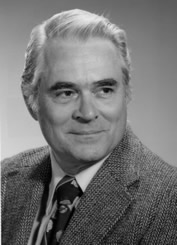

|

|
IN MEMORIAM
Francis H. Moffitt
UC Berkeley
Professor of Civil Engineering, Emeritus
1922 – 2007
Francis H. (Frank) Moffitt, professor of civil engineering, emeritus, died of complications from pneumonia on April 21, 2007 in his home at Berkeley, with his wife and daughters at his side. He was 84.
Frank was born on October 16, 1922 in Akron, Ohio, where he was raised. He grew up loving maps and the outdoors, and took up photography in high school. These interests portended the future profession to which he would devote his entire career.
After high school, he enlisted in the U.S. Army Air Corps just prior to the attack on Pearl Harbor. During World War II, he was stationed at an Army Air Corps photo laboratory in Panama, processing aerial photos of the war in the Pacific. Upon his discharge from the service in 1945, he enrolled in Syracuse University, where he studied civil engineering with an emphasis on photogrammetry and photo interpretation (the quantitative determination of the shape, size and position of photographed objects from measurements made on the images, and photo interpretation, the qualitative analysis and evaluation of the nature of the photographed objects, which represent the broad field now known as remote sensing). He earned his bachelor’s and master’s degrees in civil engineering in 1949 and 1950, respectively. Following graduation he continued at Syracuse as an instructor of photogrammetry.
Frank began his 36-year career at Berkeley as an assistant professor in 1951, retiring in 1987 as a professor emeritus of civil engineering. During summers in the period 1950-1955 he also served as a topographic engineer with the U.S. Geological Survey, the U.S. Army Corps of Engineers and the National Park Service.
Colleagues remember Frank as a strong instructor, garnering praise from both UC Berkeley students and from professionals who attended the many short courses he taught over the years. His two textbooks, Surveying and Photogrammetry, have provided the fundamentals to many thousands of civil engineering, forestry, and remote sensing students throughout the world. He has been a significant contributor to his chosen field through his research efforts, publications, and active participation in the professional organizations in his areas of expertise.
Frank is credited with helping to transform surveying techniques through a project with Hewlett-Packard to develop the electronic distance measuring device, which uses emitted, modulated light waves transmitted to a passive reflector to determine distances, both indoors and outdoors.
A colleague has stated: “Frank was skilled in evaluating and reconstructing events as they happened in three dimensions from measurements and analysis of images in single or overlapping photographs. He often applied those skills to determine the likely causes of vehicle and industrial accidents and was quite outstanding in the use of photogrammetric and surveying procedures for the use of forensics in court. He was very good at recreating the scene based upon pictures, and was also known for his skill and judgment as an expert witness in court cases involving accidents.”
Frank did not hesitate to use photogrammetry in innovative ways, including applications in bioengineering. He published numerous papers on the use of photogrammetry in dentistry and orthodontics to study teeth and jaw movements, and in hip replacement or prosthesis surgery to evaluate joint movement. He was also a pioneer in the use of off-the-shelf cameras for close-range photogrammetry in such applications as determining the configuration of ship waves and structural deformations in beam connections.
Frank was very active in the American Society for Photogrammetry and Remote Sensing (ASPRS). He served as the first president of its Central New York Region, president of the Northern California Region, and finally as president of the society in 1979. Other highlights of Frank’s contributions to the ASPRS include serving as chairman of the Education Committee and as U.S. reporter for Commission VI of the International Society for Photogrammetry and Remote Sensing (ISPRS). He also served as chairman of a committee to form the society’s Professional Practices Division that was implemented in 1983, and he was selected to serve as the director of this division in 1985. Frank’s leadership and devotion to the ASPRS have been recognized by the society, and he was elected an honorary member in 1985.
Frank has also been recognized for his outstanding contributions to the American Congress on Surveying and Mapping (ACSM), serving, for example, as a national director and as chairman of the Education Division. Other recognition included election as a life member and honorary member of the Northern California Section of ACSM. In his leadership role in both ASPRS and ACSM he played a significant role in the formation of the Management Association for Private Photogrammetric Surveyors (MAPPS). Frank later served as president of this organization in 1986-87.
Frank’s career and professional activities cut across the surveying and photogrammetry fields. Probably no other individual in either field has done as much to bridge the gap between the surveyors and geodesists and the photogrammetrists and remote sensing professionals. Because of his significant contributions to these fields, ASPRS, ACSM, and MAPPS have jointly established The Francis H. “Frank” Moffitt Scholarship Award.
Frank is survived by his wife, Mary Kathleen Boni Moffitt, of Berkeley; daughters Mary Elmstrom of Woodland, California, Eileen Frelier of Three Forks, Montana, Kathleen Vinci of Richmond, California, Ann Zacharias of Pittsfield, Maine, Madeleine Gerdes of Los Altos, California, and Margaret Goebel of Mountain View, California; and sons, Nicholas Moffitt of Gig Harbor, Washington, and Anthony Moffitt of Tyler, Texas; and 16 grandchildren.
Carl L. Monismith
James M. Anderson
Edward L. Wilson